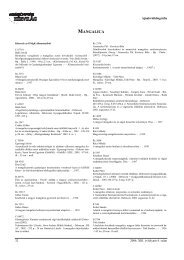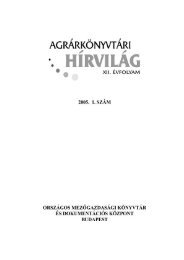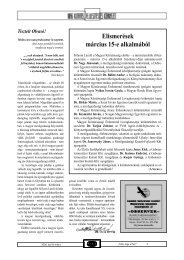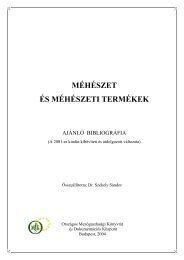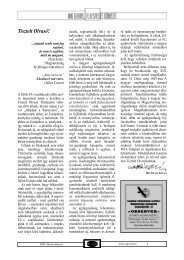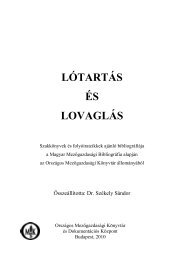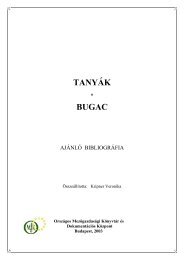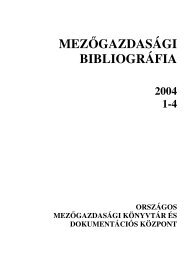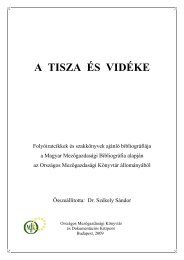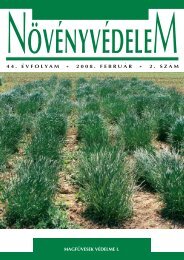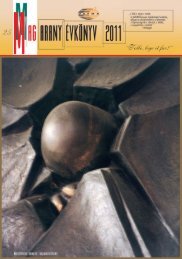hUNGARiAN AGRicUltURAl RESEARch
hUNGARiAN AGRicUltURAl RESEARch
hUNGARiAN AGRicUltURAl RESEARch
You also want an ePaper? Increase the reach of your titles
YUMPU automatically turns print PDFs into web optimized ePapers that Google loves.
Table 2: Some recommendations based on the Hungarian Feed Codex published in 1990<br />
Feed name Standard Particle size ranges<br />
Feeds of animal origin MSZ 21340-86T 80% below 2 mm<br />
20% between 2–3 mm<br />
Feed meal from wheat MSZ 08-1358-81 100% below 0.67 mm<br />
Ground rye for feed purposes MSZ 08-1367-81 100% between 0.32–1.6 mm<br />
Feed meal from corn Feed Codex I. ’84 80% below 0.8 mm<br />
Table 3: The effect of particle size on feed conversion of pigs [6]<br />
Particle size (mm)<br />
in order to ensure the improved<br />
utilization and better homogeneity<br />
of the feed mix.<br />
In the case of a traditional<br />
milling of agricultural products<br />
farms apply the accustomed old<br />
‘well proven’ settings with their<br />
existing devices. However, in<br />
connection with the changes that<br />
have taken place in the energy<br />
sector and in the field of food<br />
safety, it is worthwhile to consider<br />
the setting up of a more<br />
economical and more flexibly<br />
applicable system which can be<br />
integrated with the existing one.<br />
At greater farms, the electronic<br />
machinery designed earlier with a<br />
very great factor of safety requires<br />
considerable financial resources in<br />
advance on an annual basis. With a<br />
minimal investment, regular<br />
monthly expenses can be reduced<br />
by equipping electric motors with<br />
frequency drives. Thereby a softer<br />
start and a controllable input/<br />
output performance can be<br />
achieved. There are a lot of<br />
manufacturers on the market<br />
offering these products in wide<br />
ranges of performance.<br />
In the case of conventional<br />
arrangements a suitable screen is<br />
fitted prior to the onset of milling<br />
in order to set the output, i.e. the<br />
desired particle size. For the<br />
Feed conversion efficiency (kg/kg)<br />
> 1 3.00<br />
0.9–0.7 2.92<br />
0.7–0.6 2.76<br />
prevention of eventual<br />
overloading during operation the<br />
position of the bolt lock is<br />
modified at the place where the<br />
material enters, with the<br />
intervention of the operator.<br />
The modification of revolution<br />
number is not a customary solution<br />
in the field of milling of<br />
agricultural products. Our<br />
investigation aims at<br />
demonstrating that through the<br />
alteration of the peripheral<br />
hammer speed the same particle<br />
size can be produced as with the<br />
traditional change of screen. For<br />
the purpose of the measurements<br />
P elec. [W]<br />
a f0 [m 2 /kg]<br />
w [%]<br />
0 [kg/m 3 ]<br />
size<br />
…<br />
Elec.<br />
Motor<br />
feeder<br />
bolt lock<br />
n 1<br />
[rpm]<br />
A incoming [m 2 ]<br />
Drive<br />
mechanism<br />
the existing hammer mill was<br />
equipped with measuring devices.<br />
The input and output parameters of<br />
the experiment are illustrated in<br />
Figure 1. [4]<br />
The original design was<br />
completed with a frequency drive,<br />
marked in bold in the figure,<br />
suitable for changing the number<br />
of revolutions, with devices<br />
signalling the number of revolutions<br />
(n 1 , n 2 ), a torque meter (M 2 ),<br />
a thermometer (T), a bolt lock<br />
position transducer (A incoming)<br />
and with a load cell (m) for<br />
measuring the weight of the meal<br />
coming out. The conditions of the<br />
gravity feed and discharge were<br />
not changed and I used a sieve<br />
with the same mesh size for the<br />
same series of experiments.<br />
Measurement results were<br />
recorded using a data collector<br />
measuring over eight parallel<br />
channels with a high speed<br />
Gear : v-belt<br />
Continuously variable: frequency drive<br />
M 2 [Nm]<br />
n 2<br />
[rpm]<br />
(input of material)<br />
Q 1 [kg/s]<br />
Hammer<br />
mill<br />
Figure 1: Design of the experimental apparatus, input, output<br />
variables and parameters<br />
Q 2 [kg/s]<br />
T 2 [ o C]<br />
m [kg]<br />
a f [m 2 /kg]<br />
sieve analysis<br />
Replaceable screen<br />
size<br />
live surface<br />
profile<br />
14 Hungarian Agricultural Research 2009/3–4



